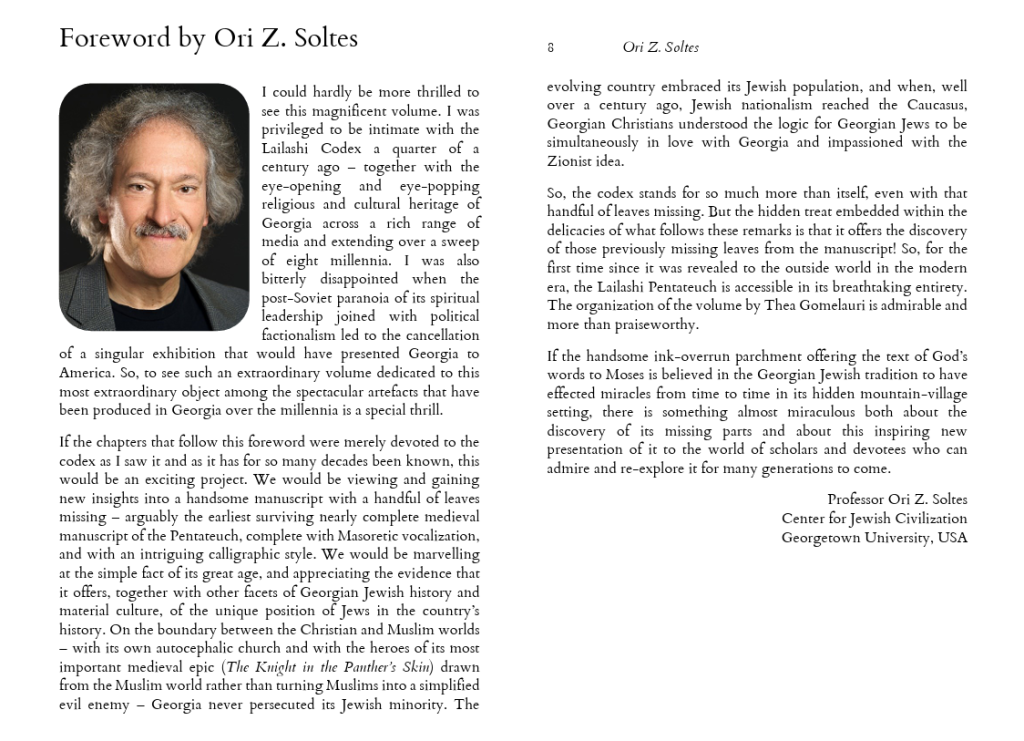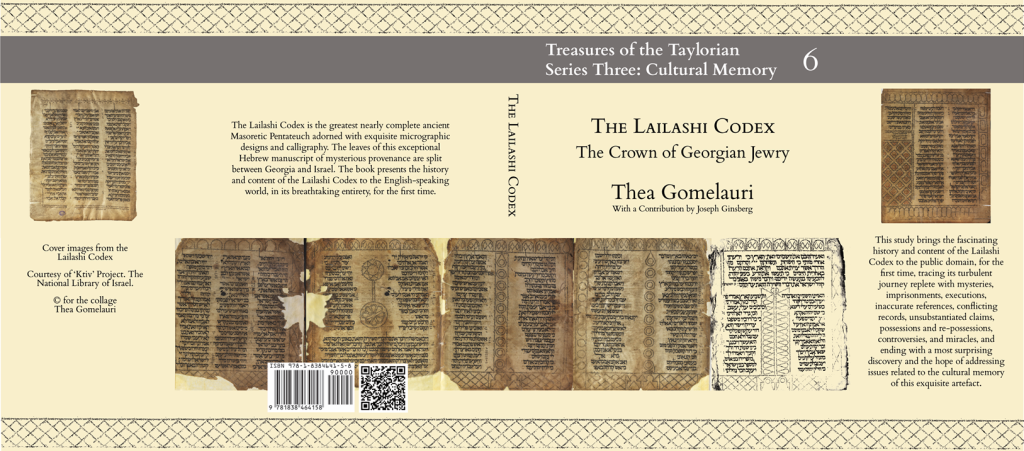
A Video Recording

Available for order!
‘This book tells the fascinating story of the Lailashi Codex, the priceless medieval Hebrew Masoretic Pentateuch, from its earliest known history as the prized possession of the Jews of Lailashi (Georgia) to its present place in the National Manuscript Centre of Tbilisi, after miraculously surviving the vagaries of Soviet appropriation. Dr Thea Gomelauri’s meticulous description of the manuscript gives a wealth of information on the codicology of the codex and its scribal peculiarities, including the palaeographical signs used to differentiate between the weekly readings of the Torah.’ – Professor Anna Sapir Abulafia, FBA, Professor Emerita of the Study of the Abrahamic Religions, Faculty of Theology and Religion, University of Oxford.
‘One hundred and fifty years after the first news on the manuscript, Dr Thea Gomelauri’s Lailashi Codex presents the first and long-awaited study of one of the most ancient Hebrew Pentateuch, together with the Sassoon and Leningrad Codices. The Lailashi Codex is an invaluable treasure both as a textual witness of the Masoretic Tradition of the Hebrew Bible, and as an artefact for its breathtaking micrography. Nevertheless, it had been completely overlooked by scholars due to the difficulties in reaching the text in Georgia, and because of the lack of any study or edition. Dr Gomelauri’s work fills that void. In addition, and for the first time, the very significant missing leaves of the manuscript, hosted in Israel, are reintegrated into its original milieu. Waiting for a digital or commercial facsimile edition, Dr Thea Gomelauri’s book will become an indispensable tool for the study of the Hebrew Bible.’ – Reverend Professor Ignacio Carbajosa, Professor of Old Testament, San Dámaso Ecclesiastical University, Madrid, Spain.
‘The Lailashi Codex is a great cultural treasure, and Dr Gomelauri’s book rectifies the history of its neglect. I learned something new on practically every page. A real “highlight” was learning how biblical manuscripts were, in the eyes of the Communists, “sources of deceit and fleecing of the working class.” The story of recovering Shota Rustaveli’s Jerusalem fresco, and the role the Lailashi codex played in it, is terrific. Dr Gomelauri would make a fine investigative journalist.’ – Professor Alan Cooper, Elaine Ravich Professor of Jewish Studies, and the former Provost of the Jewish Theological Seminary, NY, USA.
‘This is an eye-opening work. The Masoretic Text, the text curated by the Masoretes for more or less a millennium, is the starting point for any study of the Hebrew Scriptures, and the Dead Sea Scrolls have confirmed that their text is a precious testimony to the care with which they copied the Scriptures over the centuries. The emergence into Western European awareness of such a careful copy of this text that looks as if it might be as old as the tenth or eleventh century and thus be at least as old as our standard versions is therefore an exciting moment. And the tale about it that Dr Thea Gomelauri tells is a fascinating one.’ – Reverend Professor John Goldingay, DD, Senior Professor of Old Testament, Fuller Theological Seminary, CA, USA.
‘This book introduces readers to one of the most important and understudied masoretic Torah manuscripts as well as to the Georgian Jewish community who preserved and treasured this sacred text for centuries and from whom the Soviet communists expropriated it. While scholars who specialize in the textual history of the Bible will benefit greatly from Dr Thea Gomelauri’s detailed analyses of the manuscript and its unusual features, anyone interested in Biblical Studies or in the broader sweep of Jewish history will learn much from the stories and history surrounding the Lailashi Codex and its rediscovery.’ – Professor Joel Kaminsky, Morningstar Professor of Jewish Studies and Professor of Biblical Literature, Smith College, USA.
‘The two parts of the Lailashi Codex are each fascinating in different ways. The cultural history told in the First Part opens an entire area of Jewish history – the intellectual history of Lailashi and the surrounding Georgian regions – that is underappreciated and deserves more study. The codex studied by Gomelauri makes it clear that this was no backwater, though: it is a beautiful manuscript written to exacting standards. The Second Part is a meticulous analysis of the text itself, which documents numerous interesting features and adds data to many topics of inquiry into the traditions and history of the manuscript. The book includes three leaves housed in the National Library of Israel and identified recently by Joseph Ginsberg who is given the space to tell the story of the discovery from his own perspective and add a chapter of analytical work, as well. Kudos to Dr Gomelauri on such excellent work!’ – Professor Aaron Koller, Professor of Near Eastern Studies, Yeshiva University, NY, USA.
‘It is truly a remarkable Hebrew Bible codex, not only for its intrinsic value as a Bible but also for its life story and career as a book. The total story is fascinating and riveting.’ – Professor David Stern, Harry Starr Professor of Classical and Modern Hebrew and Jewish Literature, Professor of Comparative Literature at the Near Eastern Languages and Civilizations Department, Harvard University, USA.

The Lailashi Codex is the greatest nearly complete ancient Masoretic Pentateuch adorned with exquisite micrographic designs and calligrams. The leaves of this exceptional Hebrew manuscript of mysterious provenance are split between Georgia and Israel. The book presents, for the first time, the history and content of the Lailashi Codex to the English-speaking world in its breathtaking entirety.

Lailashi, a remote village at the footstool of the Caucasian mountains holds one of the most tantalising and valuable discoveries in biblical scholarship and Jewish history. It is the home of the Lailashi Codex, an ancient Masoretic manuscript, which belongs to the exclusive group of the Hebrew biblical manuscripts known as Vavei Ha’Amudim (words beginning with the letter vav are the first words on each leaf of the manuscript except for the six cases defined by the scribal tradition).
This publication brings the fascinating history and content of the Lailashi Codex to the public domain, for the first time, tracing its turbulent journey replete with mysteries, imprisonments, executions, inaccurate references, conflicting records, unsubstantiated claims, possessions and re-possessions, controversies, and miracles, and ending with a most surprising discovery and the hope of addressing issues related to the cultural memory of this exquisite artefact.
The provenance of the Lailashi Codex and its journey throughout centuries is as mysterious as its authorship and ownership. According to the legend, it was brought to Georgia on an angel’s wings. The villagers saw a floating book in a river and rescued it from the stream. This unique artefact was said to have miracle-working powers. It became the best-kept secret of Georgian Jewry.





